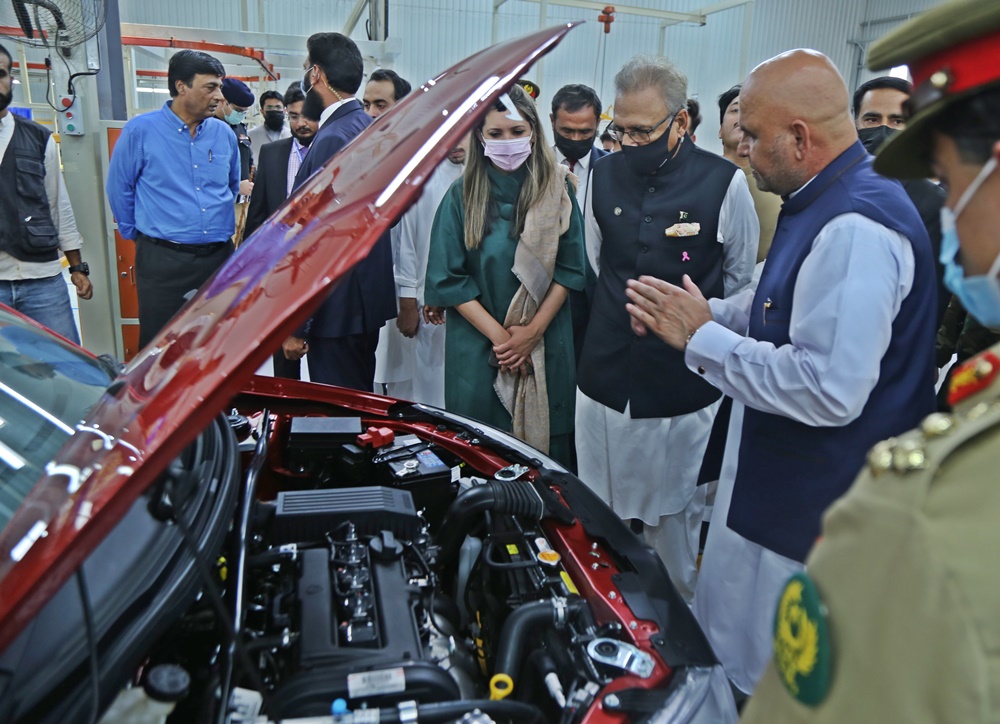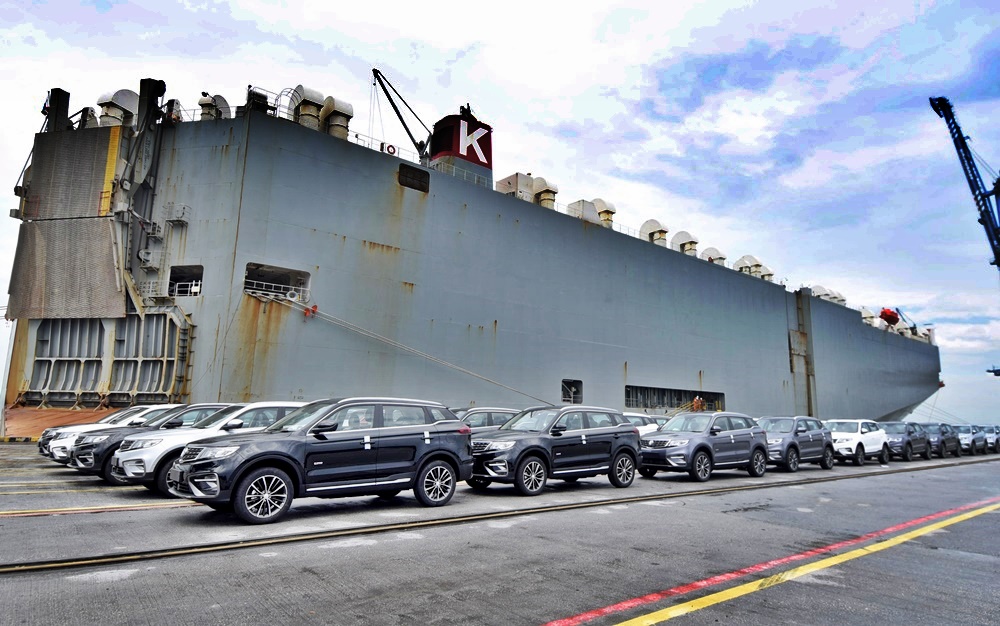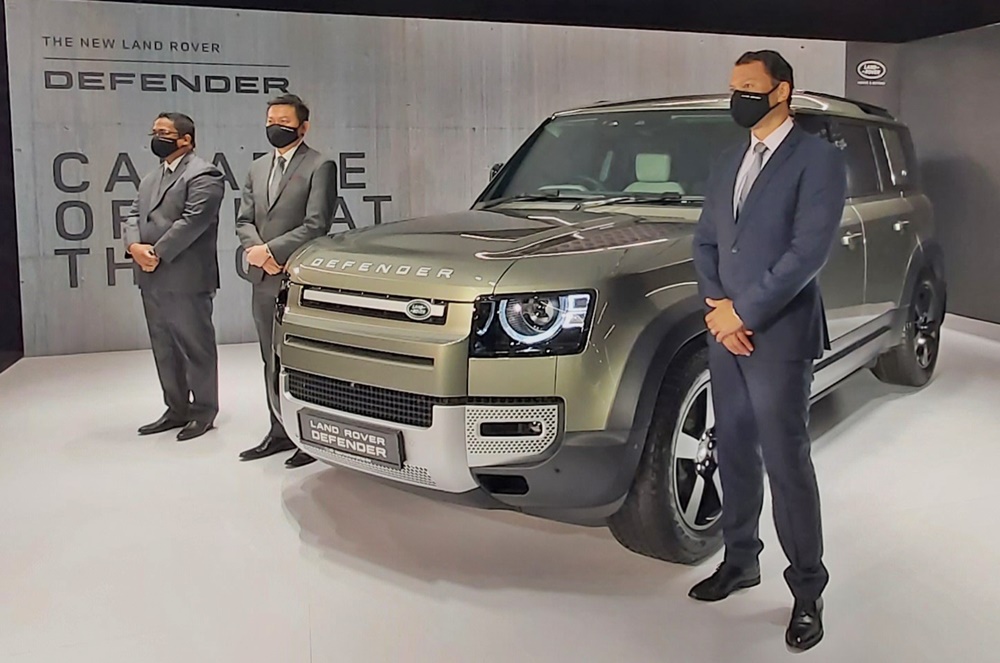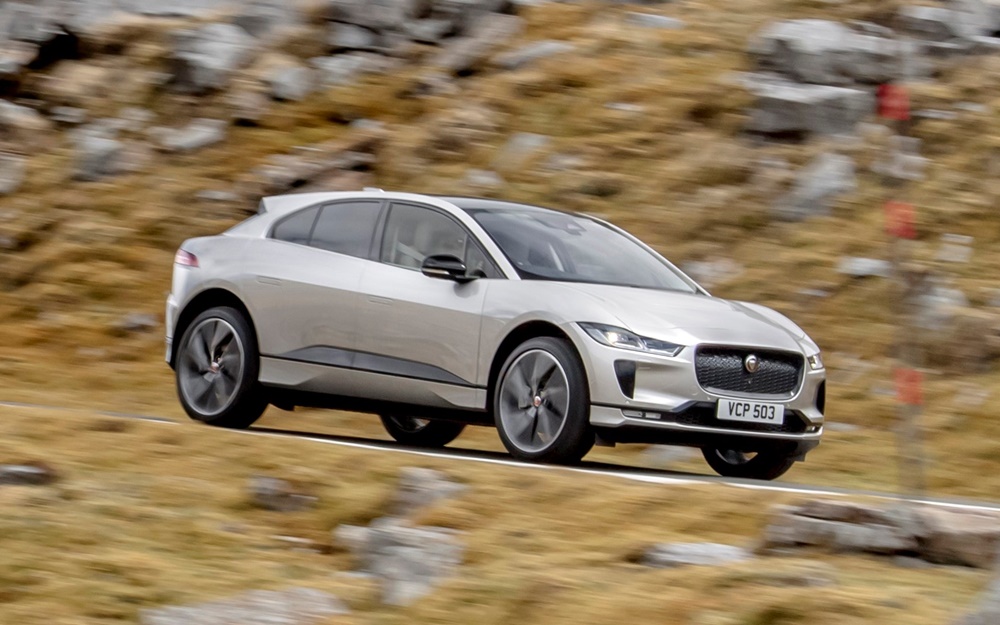The COVID-19 pandemic affected business activity all over the world, impacting sales and delaying projects. But now that the situation is easing, many activities are quickly resuming and some projects that may have been suspended can now proceed. One of them is the local assembly of Protons in Pakistan at the factory which was under construction since March 2019. Recently, the first units of the Saga began to come off the production lines, setting a new milestone for Proton.
The Saga is the first Proton model to be assembled by Al-Haj Automotive, the exclusive distributor of Proton models in Pakistan, at their new greenfield factory in Karachi. The plant, built with an initial investment of US$20 million (about RM83.1 million), will create 2,000 direct employment opportunities in its first three years of operations. It is estimated that a further 20,000 indirect jobs will also be created as a result of the new plant being established.
25,000 units a year
The initial capacity of 25,000 units a year is expected to meet the potential sales volume of the market which was about 128,000 units in 2020 but higher at around 193,000 units the year before the pandemic affected the country. As with the case in Malaysia, local assembly means that the retail prices can be lower due to more favourable taxation, a critical element in Proton’s aim to grow exports in the future.
Speaking during the roll-out ceremony, Hilal Khan Alfridi, Chief Executive Officer of Al-Haj Automotive said: “The successful assembly of the Proton Saga in Pakistan is the culmination of the hard-work and untiring efforts of Proton, the entire Al-Haj team, its suppliers and vendors. Even with COVID-19 restrictions in place, we continued to push to build our new assembly plant and as such, we are confident it will set new industry standards and enable us to introduce more products that meet the international quality levels set by Proton.”
X70 assembly to follow
The X70 SUV is to be second model assembled in Pakistan. Launched in December 2020 as an imported CBU model, the X70 met with positive response. Together with the final batch, the total number exported to Pakistan is 602 units. The first locally-assembled units are expected to be available by the end of this year.

“Despite COVID-19 severely affecting our project timelines in Pakistan, demand for Proton models in the country remains high for both the Proton Saga and Proton X70 attracting a strong following. Al-Haj has received 2,500 orders for the Saga and over 2,000 orders have been placed for the X70, so we wish to thank the customers for their belief in our products and especially their patience and understanding over the delays in receiving their cars,” said Roslan Abdullah, CEO of Proton Edar.
“Now that the final shipment is on the way and local assembly has started for the Saga with the X70 to roll off the production line before the end of the year, we can finally work to catch up to market demand. This will allow Al-Haj Automotive and Proton to establish a strong market presence in the country to benefit future sales growth,” he added.

Sharing assembly expertise
With export sales being one of the pillars to achieving its long-term goals, Proton’s commitment to the Pakistan market extends beyond the shipment of CKD packs and consumable parts. It also includes human resources and there are currently 20 Proton staff specialising in various manufacturing related fields stationed in Karachi to assist in assembly operations.
“After 37 years of vehicle assembly experience, Proton has accumulated a wealth of in-house expertise that can be shared with our overseas partner. Having operated in various market conditions, we can quickly adapt to different scenarios, so we hope to be able to play a major role in ensuring the success of the brand in Pakistan,” Encik Roslan said.
With greater attention to overseas business, Proton aims to double export volumes in 2021
MPVs evolved from window vans and were initially simple people-movers. Over the years, some manufacturers have found growing demand for more luxurious versions of such vehicles, with models like the Toyota Alphard and Vellfire being very popular.
To capture a slice of this growing market, Hyundai has also come out with a luxury MPV called the Staria and it is now available in Malaysia through Hyundai-Sime Darby Motors (HSDM). Available in the 7-seat Premium version, the Staria is priced from RM358,888 (without insurance and with partial sales tax exemption). The price varies depending on the warranty period the customer wants. The base price comes with a 2-year or maximum of 50,000 km warranty. For another RM10,000 more, HSDM will provide a warranty of 5 years or maximum of 300,000 kms, plus 3 years (or maximum of 50,000 kms) free scheduled service.
Unique spaceship design theme
The Staria has a unique appearance which certainly makes it stand out anywhere. While MPVs typically have a cubic form which allows for the most efficient interior space, Hyundai’s designers have given it a design that is said to be like a spaceship. It’s a sleek streamlined form that is said to be like the curve of light that illuminates the Earth’s horizon at sunrise when viewed from space.
From any angle, the Staria’s styling draws attention. For instance, the front is embellished with horizontal daytime running lights (DRLs) and a positioning lamp, together running across the width of the vehicle, complemented by a bold, wide radiator grille with a unique pattern.
The same body colour for all frontal parts is used and gives a monolithic look that is modern and even futuristic. To highlight certain elements and give a premium look, brass chrome treatment is applied to the emblem, grille, headlamp bezels, front and rear bumpers, wheels, side mirrors and door handles.
The Staria’s 5253 mm long body sits on a 3273-mm wheelbase and has a 1997 mm. The beltline is low, allowing the side windows to be large and panoramic, which suggests a spacious interior – which is the case. The cruise ship-inspired interior has an open and unique atmosphere through its innovative design architecture which follows traditional Korean ‘hanok’ architecture.
Premium Relaxation Seats
The sense of spaciousness allows passengers to feel as if the outside scenes are an extension of the vehicle interior. Premium Relaxation Seats are provided in the second row and these have power recline as well as slide along the floor to vary cargo space. A one-touch relaxation mode makes the seats recline automatically to a posture that comfortably disperses the passenger’s weight and improves overall body balance. Even when the seats are reclined by this mode, there is enough room for an adult passenger to sit comfortably in the third row.
The cargo space available varies depending on the arrangement of the seating configurations. While the 7-seat configuration may have reduced cargo volume, the 2 and 3-seater versions which can be optimized for business use have maximum cargo space of almost 5,000 litres.
Futuristic dashboard theme
The futuristic theme of the exterior is also adopted on the dashboard with an advanced 10.25-inch front touchscreen and a button-type electronic shift lever. The digital cluster is located on top of the dashboard while the smart infotainment system includes a display from a wide-angle camera for the driver to view rear passengers.
To have the right atmosphere, there is a 64-colour ambient mood lamp. Its direct and indirect lighting can selectively illuminate the cockpit, console, doors and cargo areas. The premium ambience is enhanced by the Bose sound system which comes standard and is optimised for the large cabin volume.
Turbodiesel with shift-by-wire transmission
HSDM is still one of those companies that offers diesel-powered models and the Staria comes with a familiar 2.2-litre CRDi turbodiesel with an output of 177 ps/431 Nm, mated to an 8-speed automatic transmission operated by a simple electronic shift-by-wire system. With the high-efficiency, air-cooled turbocharger that has an improved compressor and turbine wheel performance, low speed performance is stronger and peak torque is available from 1,500 rpm. HSDM doesn’t mention fuel compatibility although they would have done extensive testing with local biodiesel to ensure there are no issues.
As it can carry up to 7 people, the Staria would need the highest level of vehicle safety. It is equipped with a full suite of Hyundai Smartsense active safety and driving assistance technologies. With its large size, especially the long body, the Blind-spot View Monitor, Blind-Spot Collision Avoidance Assist and Rear Cross-Traffic Collision-Avoidance Assist systems would be of very useful.
“Hyundai is expanding its offerings to include more premium vehicles that offer innovative features for a unique in-car experience. The Staria Premium aims to offer unique value propositions for customers seeking a luxurious experience in an MPV,” said Jeffrey Gan, Managing Director of Retail and Distribution, Sime Darby Motors.
While the Staria is launched today, units are not immediately available. Understandably, given the price, it is new territory for HSDM and remembering the times when they have sold high-priced models, they probably want to avoid having too many stocks in hand waiting to be sold. Customers have to specify what colour they want from the choice of five (white and mostly greyish or silver shades). Then depending on production slots, it could take 3 to 6 months before the vehicle gets to Malaysia for delivery.
Older Hyundai models can now be covered under HSDM’s Extended Warranty programme

When the Bugatti Chiron made its debut at the Geneva International Motorshow in 2016, it was announced that the production run would be limited to 500 units. Just over 4 years after the first deliveries to customers began in March 2017, over 460 units have been built and less than 40 build slots left to be allocated.
The final units being built or scheduled to be built are in Chiron Pur Sport and Chiron Super Sport form only. Joining the Chiron family in 2020, the Chiron Pur Sport built upon the exceptional Chiron foundation to offer customers a truly uncompromising hyper sports car that is optimized for dynamic agility and downforce.
With an entirely new aerodynamic, transmission and weight configuration, the Chiron Pur Sport effortlessly delivers thoroughbred performance. The model has a 50-kg weight reduction and firmer suspension, combined with a 1.90 metre rear wing and close-ratio transmission.
Ultimate Grand Tourisme
The Chiron Super Sport only appeared this year. As the quintessence of luxury and speed, the Chiron Super Sport has been designed to embrace supreme longitudinal speed without compromising luxury and comfort. It is regarded as the ultimate Grand Tourisme and defined by its longtail design, the Super Sport achieves extreme levels of aerodynamic efficiency, enabling the hyper sportscar to reach speeds of up to 440 km/h.
With an upgraded version of the Bugatti 8-litre W16 engine, the Super Sport has 1,600 ps, which is 100 ps more than the standard car. But even with 1,500 ps (and 1,600 Nm), the Chiron redefined the pinnacle of automotive engineering in the 2010s. Sprinting from 0 to 100 km/h in a claimed 2.4 seconds, it reached 200 km/ in 6.1 seconds, with the 300 km/h mark achieved in 13.1 seconds.
A world record-setter
As would be expected, Bugatti regularly set new records with the Chiron, solidifying its position in automotive history as one of the all-time greats. Its first production car record was achieved in 2017 when a Chiron went from 0 to 400 km/h to 0 within 41.96 seconds – the fastest time ever reached and officially measured at the time.
Continuing a run of unrelenting success, just 2 years later, the hypercar reached speeds once through to be unreachable by a road car. A near production prototype derivative crossed the 300 mph limit with a speed of 304.773 mph (490.484 km/h).
Related story: The German engine that was born on a Japanese bullet-train
No shortage of customers
Even with the astronomical prices starting from US$3 million (about RM12.5 million), there has never been a shortage of customers from the first day orders were accepted. 18 months from its initial announcement, 300 of the 500 cars had been sold. This sales momentum has continued and despite global challenges such as the COVID-19 pandemic, Bugatti has steadily been receiving orders for the Chiron. The USA has taken the most Chirons, contributing significantly to a record-breaking quarter in Q3.
“Our discerning customer base across the world consists of true Bugatti connoisseurs. They are hard-working, self-made individuals who regard owning one or multiple Bugatti masterpieces as the realization of a dream. They understand the devotion behind the pioneering design and engineering of each Chiron model. Their appreciation for the provenance and performance of our hyper sports cars comes from a genuine passion for the brand,” said Hendrik Malinowski, Director of Sales and Operations.
Bugatti Chiron Sport versus Dassault Rafale Marine (w/VIDEO)
Braking systems in today’s cars are no longer ‘dumb’ systems that perform only as well as the driver’s actions make them perform. Thanks to the integration of electronics and sensors, the operation of brakes is managed more by a computer working at lightning speeds to optimise stopping. The driver’s role is only to apply the pressure on the pedal, signalling the need to decelerate, and even that is now enhanced by features like Brake Assist which boosts braking pressure under certain conditions.
Brembo, a leading manufacturer of braking systems which also supplies to F1 teams, has developed a new pioneering intelligent braking system which uses artificial intelligence (AI) – SENSIFY. This system integrates current Brembo product portfolio of calipers, discs and friction materials with the most advanced software, digital technology and artificial intelligence. The result is a flexible and revolutionary platform that includes software, predictive algorithms and data management to control the brake system digitally.
Braking system becomes ecosystem
With SENSIFY, the braking system is no longer simply a sum of its parts but an ecosystem, where AI and software play an active role. Data collection is leveraged to improve the driver experience and allows the system to be constantly updated.
“By introducing SENSIFY, Brembo is pushing the boundaries of what is possible with a braking system, opening up entirely new opportunities to drivers to improve their experience on the road and customize brake response to their driving style. SENSIFY gives drivers the peace of mind they are looking for,” said Daniele Schillaci, Brembo’s Chief Executive Officer.
“SENSIFY fully embraces our vision – Turning Energy into Inspiration – and it’s another significant step forward in providing cutting-edge, innovative, intelligent and sustainable solutions to the automotive industry,” he added.
SENSE + SIMPLIFY
SENSIFY comes from the merging of two words: ‘SENSE’, a faculty by which a human perceives an external signal or stimulus, and ‘SIMPLIFY’ which means simplicity in installing at best the product in harmony with the vehicle.
Digital brain manages braking
The system is intuitive, responsive and smooth, providing the driver the expected performance when needed, combined with exceptional control. It has evolved naturally from Brembo’s heritage and know-how, combining the design of the best braking components with the integration of a digital brain and sensors that control each wheel independently. The result is more precise car handling, increased performance to give the driver more confidence.
Thanks to the optimized braking action on each wheel, combined with the absence of drag between pads and discs, emissions are minimized which is an environmental benefit.
SENSIFY also opens up opportunities in car design, offering great flexibility for carmakers and simplifying integration in any platform (electric and combustion engine) – from super sport to city car and, potentially, to the latest commercial vehicles. Brembo will offer it to the industry from the beginning of 2024.
Jaguar Land Rover (Malaysia) Sdn Bhd (JLRM), a joint venture between Sime Darby Motors and SISMA Auto since 2014, will consolidate and strengthen Jaguar Land Rover retail business operations making it the sole importer and dealer in Malaysia.
The move will see the acquisition of dealer assets and transfer of staff from both Sime Darby Auto ConneXion and SISMA Auto and the consolidation of its central business operations into the Jaguar and Land Rover Dealership at Ara Damansara, Selangor. This outlet is currently the largest Jaguar Land Rover 4S facility within the South-East Asia region. JLRM, will also be operating its retail operations located in Jalan Sultan Ahmad Shah, Penang.
According to Syed Ahmad Muzri Syed Faiz, Managing Director of Jaguar Land Rover Malaysia, this is part of its ambitious plan to improve service capabilities and drive long-term growth for the brand. JLRM’s consolidation exercise will put the company in a stronger position to serve its customers, whilst optimising retail and distribution costs, as well as overheads.
“This consolidation will be a positive move towards better operational efficiency with elevated levels of premium services which will help drive long-term growth for the company. These measures will leverage on the company’s vast experience and accumulated knowhow through the decades to strengthen its processes and deliver more value to our customers,” he added.
JLRM expects this consolidation to continue to elevate customer experiences, differentiating it from the mass premium brands. Together with digitalization initiatives, it plans to invest more on technology and will increasingly deploy digitalisation over the next few years to improve its service capacity to deliver top-notch services to its customers.
The joint venture between SISMA Auto and Sime Darby Motors brings together more than 60 years of cumulative experience in the automotive business. Both entities have been credited with outstanding performances by securing top positions in the Retailer of the Year Award 2020/21 title for their superlative service and dedication to customers.
Tuan Syed Ahmad Muzri said customers can expect more luxurious and convenient services from Jaguar Land Rover Malaysia. “Those who wish to join the Jaguar and Land Rover family will find even more value and options, available at the 167,586 sq.ft. Ara Damansara facility which houses both new and approved Jaguar Land Rover pre-owned vehicles under one roof,” he said.

JLRM will continue to invest heavily in training to grow the number of Jaguar Land Rover Master level 4 Technicians and Electric Vehicle Technology Certified Technicians in ensuring owners get the most from their vehicles. Sales and service advisors are also trained according to Jaguar Land Rover standards so that customers will always feel confident and secure as part of their purchase and ownership experiences.
Service Outreach programmes will also be curated to bring coverage to the southern region of Johore Bahru whilst it assumes retail coverage of the Northern region via its outlet in Penang Island.


As for product offerings, there will be new models in the near future from both the Land Rover and Jaguar brands. These include the Jaguar F-Pace SUV, XF Executive Sedan and I-Pace all-electric performance SUV. From Land Rover, there will be the Defender 90 following the recent launch of the New Defender 110 and an all-new Range Rover (to be revealed tomorrow).
For more information on models available in Malaysia and the locations of showrooms to view them, visit www.landrover.com.my or www.jaguar.com.my.

© Copyright – Piston.my 2024 Trademarks belong to their respective owners. All rights reserved